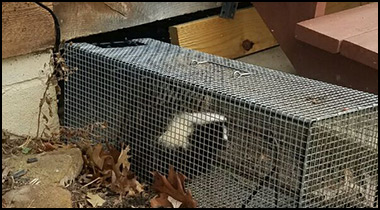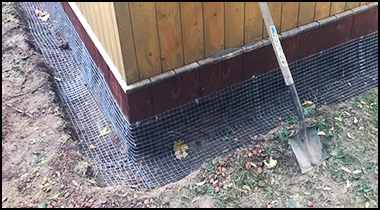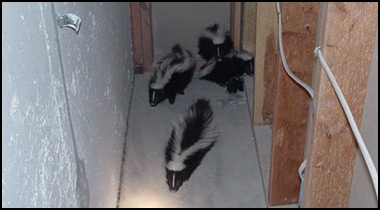Atlanta Skunk Removal Resources
Skunk Rehabber - AWARE Wildlife Center: (678) 418-1111
Free Fulton County Animal Services: 404-794-0358
Humane Wildlife Trappers of Atlanta: 678-535-3705
If you need skunk control in Atlanta, you have a few options. First, you can attempt to solve the skunk problem yourself by reading our do-it-yourself guide. If you need outside help, you can also call Fulton County Animal Services to see if they have any free resources or help for you - however, they primarily deal with dog and cat concerns. You can also call a local Atlanta wildlife rehabber, as they are typically a great resource for advice that is in the best welfare of the animal. If as a last resort you must hire a professional company, we recommend Humane Wildlife Trappers of Atlanta at 678-535-3705. To learn more about them or check their skunk removal prices, visit atlantapestanimal.com.

Atlanta Skunk Trapping and Removal

Preventative Repairs & Exclusion

Atlanta Skunk Removal From Structures
In many cases, preventative measures can solve your Atlanta skunk problem - keep garbage secured, pet food indoors, and most of all when it comes to skunks, secure the perimeter of your shed, porch, deck, or house with a barrier - lattice or steel mesh is good, and it keeps Georgia skunks from going under the structure. If trapping and removal of the skunk is the only option you have, please do so with the help of a local agency or professional company who knows how to do it humanely and legally. Browse the resources of this site for more educational information.
Frequently Asked Questions:
Prevention: How to Keep Skunks Away
What to do with a skunk after I catch it?
Is it legal for me to trap a skunk?
How to remove skunk odor
Is a skunk active during the daytime rabid?
What does skunk feces look like?
Atlanta Skunk Control Information: Do skunks run out of spray?
Skunks are infamous for their main defense mechanism, their stinky musk, but exactly how many times can they use that? Let's look at how a skunk responds to danger, and give you the answer to this question. If you come upon a skunk and it feels threatened for whatever reason, it will first run through a serious of motions designed to intimidate you and run you off. These include hissing, growling, showing of teeth and stomping. They will also dance on two feet, brandish their tails in the air, and even bend in a U shape so they can stare you down and point their anal glands at you at the same time. They will hold off on spraying you as a last resort. If all else fails, then they will let loose with the stinky oily sulphurous mixture that clings to everything it touches.
Not only is the spray tough to remove from most anything, it is the foulest of smells, it is long lasting, and it can cause problems if you are sprayed in the eyes or soft tissues. Many people and animals have been rushed to the doctor after being sprayed in the face. It can cause extreme burning and even blindness. You might wonder why the feisty skunk doesn't just start out spraying and be done with it. The liquid it sprays has to be manufactured inside the skunk's body, and then fills up the sacks under its tail. At any given time, the skunk can produce enough liquid to effectively drench an adversary about six times. Once the skunk has exhausted its spray, it can take up to ten days to replenish its supply.
This means that during that time, the skunk's only means of defense is its show of bravado. That does not mean that it will not try to bite you with its nasty teeth, or claw you with its long sharp claws. Skunks are not skillful fighters, and rely on their spray to save them from most predators. Without it the feel defenseless and will sometimes remain in their dens until they have replenished their supply, rather than chance a dangerous encounter. Keep in mind, even being sprayed once by a skunk is a pretty awful thing. It is best not to try to force them to empty their sacks in one encounter. The overwhelming stench could be devastating
Remember, for free services you can try (678) 418-1111 or 404-794-0358, but if you need to pay for professional help, check the prices at the atlantapestanimal.com website. Or follow our do-it-yourself guide!

